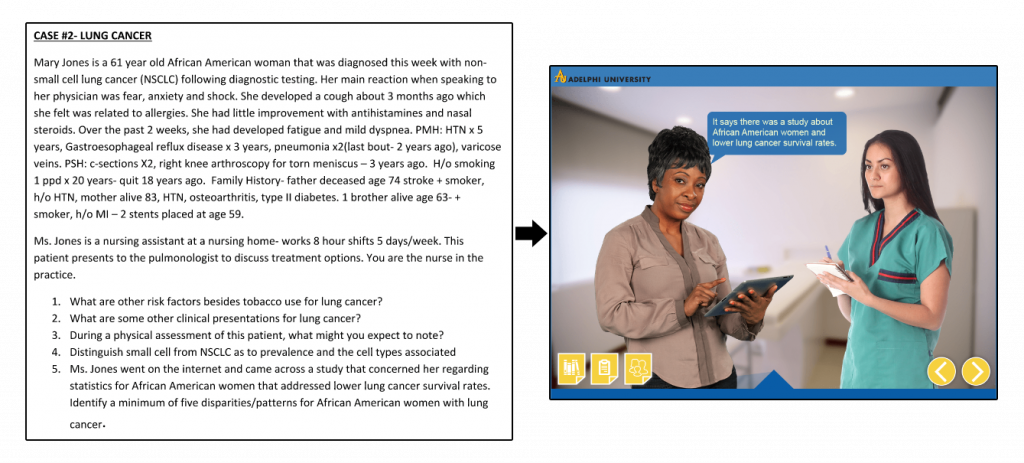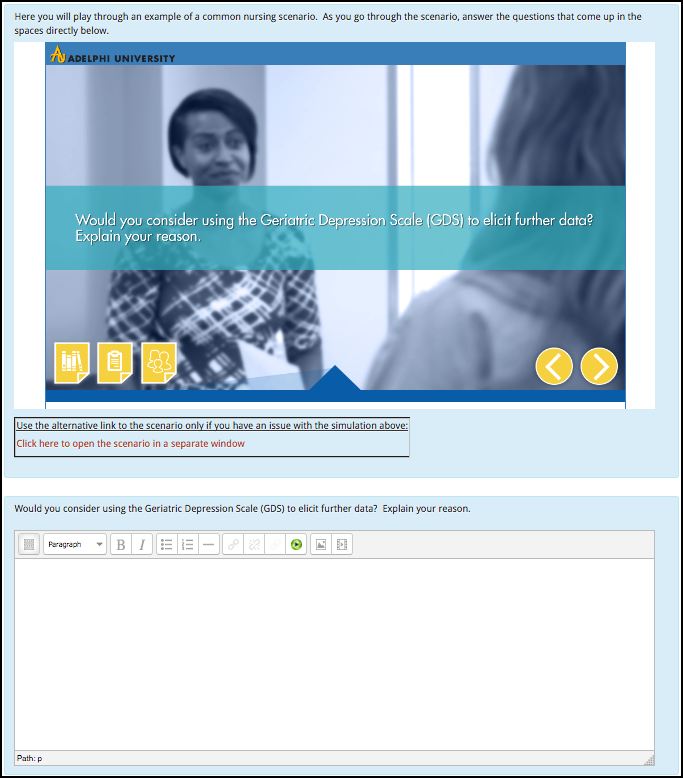Professor Stefni Bogard has been converting her course, Health Assessment Throughout the Lifespan, to an online format.
Over the last year, Professor Stefni Bogard has been working with Instructional Designer Belle Gironda on the development and implementation of an online course for Nursing students. The course, Health Assessment Throughout the Lifespan, is one that she’s taught frequently in a traditional classroom setting. She’s been excited about her decision to teach in a different format, but curious as to how some of her materials would translate into an online environment.
Early on in the course development process, they reviewed the materials that Stefni typically incorporates into her traditional class. These materials included a set of practical case study examples for students to read to consider realistic Nursing situations. The case studies were distributed as handouts, and students would fill out the answers or discuss them.
While transitioning the learning content to the online environment, they both got excited about the opportunity to redesign these into a more interactive learning experience. Working with Robby Lucia, Rui Huang, and Tom Jennings from the FCPE Media team, the group collaborated to develop these examples into a more connected and engaging learning experience. Using Adobe Captivate, the handout case studies were transformed into interactive simulations.
 The learning objectives were as follows:
The learning objectives were as follows:
- Formulate valid nursing diagnoses, identify collaborative problems and make referrals based on data collected from patient.
- Use research data, nursing informatics, and multiple data resources to determine patient centered expected outcomes.
- Interpret assessment data to determine appropriate nursing interventions.
- Identify normal and abnormal findings and associate them with wellness and illness in patients.
- Apply knowledge of demographic health disparities to the diagnosis process.
The simulations were designed to help guide students with respect to these objectives. Useful information was provided in the form of conversation, data pop-ups, research links, etc. Questions were interspersed into the presentation at relevant points to connect the practical experience with the classroom assessment. Text transcripts were provided for accessibility friendliness and as an alternate review option. And each case study was embedded within a Moodle Quiz module to collect student answers for review.

Images, videos, simulations, etc. can be embedded into Moodle Quizzes.
The case studies help students explore a variety of health related patient issues, including: communicating with patients, interpreting data, making accurate assessments, and recognizing health disparities. Professor Bogard has found this format to be useful for reinforcing her teaching, and noted high student engagement. We surveyed the students on their experience, and the feedback was extremely positive. All of the respondents agreed or strongly agreed that they allowed them to integrate knowledge about specific health issues with knowledge about specific patients to make diagnoses and care recommendations. One student specifically mentioned that they have been out of the field for two years and that the case studies served as a good refresher.
Regardless of the medium, case studies are an effective option for professors to craft meaningful learning experiences. If you’re interested in incorporating case studies with your teaching, check out these resources:
- Boston University: Using Case Studies to Teach
- Carnegie Mellon University: Case Studies
- Stanford University:Teaching with Case Studies
For further information, please contact:
Faculty Center for Professional Excellence (FCPE)
Alumnae Hall, Room 123
p – 516.877.4220
e – fcpe@adelphi.edu